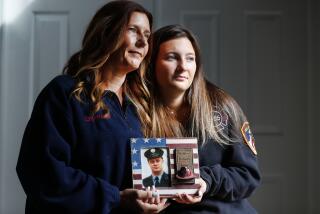Flags Fly Where Cool Once Ruled
The World Trade Center has been destroyed, but this has been also been crushing defeat for irony, cynicism and hipness. Here in New York, the city that gave the world “Sex and the City” and “Seinfeld”--the show about nothing--the victors now are sincerity, patriotism and earnestness. Consider these snapshots from the new New York, where post-modernism is post-facto:
Friday night in Washington Square Park in Greenwich Village. This is the place where, in the past, every Bohemian came to dig the scene, every radical came to raise the rabble, every college doper came to score a joint.
There’s a folk-singer/guitarist, Adam Tucker, 31, leading a gentle sing-along. He’s scruffy, all right: long-haired, hasn’t shaved in a while, wearing a “Rent” T-shirt. But he’s got an American flag fitted into the frets of his guitar.
Others in the crowd around him have U.S. flags stuck in pockets, sewn onto their jackets, made into kerchiefs on their heads. Just about everyone has a ribbon or some little insignia of respect and remembrance. I ask myself: When’s the last time I saw a flag--an American flag--here? It’s been awhile. Like never.
Saturday night, along the West Side Highway at Canal Street. This is the edge of the security perimeter that cordons off the blast zone and the relief effort. A crowd has gathered by the Mobil station, standing respectfully behind the police line.
They’re New Yorkers, which is to say they’re everything: young, old, black, white, straight, gay and everything in between. But most are young and cool, or at least formerly cool; this is, after all, the West Village, which is heavily gay, and TriBeCa--Triangle Below Canal--which is totally trendoid. But they have one thing in common: Every time an emergency worker walks or drives in or out--and there are hundreds of them--the crowd erupts in cheers. Ask yourself: When was the last time Manhattanites energetically huzzahed blue-collar workers?
Most of these working stiffs haven’t been applauded since their wedding or since their team won the Benevolent Assn. softball championship. Guys who were lucky to have finished high school aren’t used to being looked up to by NYU graduates who make careers out of stocks and semiotics. But today it’s different.
The difference, of course, is that 5,000 people have been killed. No doubt some of them were ironic, cynical and hip.
When the explosion happened, the city was covered with dust. I wonder what that ash is made of. I’m no scientist, but it seems to me that if a pair of 110-story buildings become twin roaring furnaces, burning for a time at a couple of thousand degrees Fahrenheit, and then the contents of the structures are whooshed through the streets as if by a satanic bellows, then that ash must include human remains. So the towers became crematories, sprinkling remains over the whole city. In a metropolis dusted by death, it would be hard to worry about whether Carrie of “Sex in the City” sleeps with Mr. Big anymore.
Of course, the city will eventually revert to form, mostly, sort of. But ask yourself: Was Gettysburg ever the same after those three bloody days in July 1863? Or Dealey Plaza in Dallas, where John F. Kennedy was assassinated in 1963? Not many folks cut up or crack wise in such places.
Manhattan will have a formal memorial soon enough. It will be a place of hush. A place where, as Shakespeare wrote, memory holds its seat. But physical locales aside, the mental landscape has already been reordered. And since Manhattan is arguably the most influential content-provider on the planet, the wounds and the healing and the scars will be felt everywhere.
“Seinfeld” won’t disappear, of course; it’ll be rerun, somewhere, forever. But everyone now knows that there’s more to life than nothing, that some things really matter.
More to Read
Sign up for Essential California
The most important California stories and recommendations in your inbox every morning.
You may occasionally receive promotional content from the Los Angeles Times.










